A day in Bethlehem must include visiting the birthplace of Jesus.
The lighting of this first photo just turned out different than all other photos. I wasn't using any flash for the entire duration of the trip, and there was just enough darkness in the foreground that a single lightbulb above the path down to the birth site spread a brilliant glow onto the faces of the other pilgrims.
Let's step back to the start of this part of the day. This is the church from the outside. A little more than a decade ago, people were concerned about the integrity of the very ancient church building, because the roof was not in good shape, and it needed lots of repairs. But like other sites with shared ownership, it's hard to make any change occur. A project was started several years ago after consulting a third party. I believe it was nearly complete by the time of our visit.
Many people are surprised at the low entry to the church building. Nearly everyone has to duck down to get in. We could assume this is for humility or to force us to bow down. But this was a protective measure. Many churches with tall entries in the Holy Land experienced damage after warriors on horseback could ride in and cause damage. By having such a low entryway, horses could not get in, much less people on horseback.
As it turns out, when the Persians destroyed many of the oldest churches long ago, this one church was spared. Why? With it's focus on the birth of Jesus and the events surrounding that event, there is a depiction of the Magi--Persians were depicted positively. They saw they were depicted positively and couldn't bring themselves to destroy a church that would look upon them in a positive light.
Upon stepping into the church, we see high ceilings with lights dangling down from the ceiling.
The columns have artwork on them, depicting many people.
Two nearly identical photos have a slight difference. One focuses a little more on the background.
The other focuses more upon the reflective ball. Now I'm represented in the photo.
When one looks up toward the windows, one discovers various works of art up there.
We didn't have to wait the hours one might have to wait during the busy season because we came during their off-season. That can make a huge difference of multiple hours of standing without an option of sitting.
As we neared the front of the space, we were told about a man who would be selling candles just beyond the transition of rooms. The room ahead looks very interesting. I bought a couple of candles, and gave one to a friend who had a birthday shortly after my return. It seemed fitting to give a gift from the place where Jesus was born to someone for their birthday.
The next room really did have lots of stuff all over the place. Various artifacts, pieces of art, etc.
I wish these weren't so darkened. Hopefully they can restore some of these works of art sometime.
This next photo is a quick look back to the main body of the church.
We eventually reached the area where everyone spreads out in an arc in order to go down the steps to the birthplace so we can arrive more as a group. As our priest pointed out beforehand, this is the worst part of the design. Everyone will want to get down, but rather than having the stairs work like most staircases that allow people to go down one or two at a time in a fairly straight line, these steps fan out in arcs. Thus, we start with room for perhaps a couple dozen people to stand on the top of the steps, and by the time we get to the bottom, that's when we were going to get down to just one person wide. So lots of people of all ages are stuck standing on steps without any handrails, and having to take turns letting someone ahead of you or deciding to step down a step. This narrowing on a downward staircase is a terrible design. Hopefully people are charitable.
While waiting to go down or while starting to go down the steps, one can look around at much more art.
This is a more natural photo compared to the first photo displayed in this post. The first photo was taken close to the same time, but under different lighting conditions. You can already see a hint of bright light on some faces, but it's not the intense glow of the other photo.
Just above the entryway to the final staircase.
The single-file part of the stairs is more reasonable.
After going down the rest of the way, one looks to the right and sees the silver star with the hole in it, which allows you to place your hand on the spot that's traditionally considered the birthplace of Jesus. This spot does bring humility.
Above the birthplace, it looks like this.
Stepping back quite a bit into an area that looks like it might be under restoration, I saw this.
But before taking that last photo, I took this photo, which is to the right in the last photo. This is where the crib of Jesus would have been. If one is standing right in front of the birthplace, this is back and to your right by just a few feet.
When leaving, we exit to the left of the birthplace of Jesus, heading up similar steps as we used to get down. But these make more sense, because people will start single-file, and can always choose to spread out. This works much better than using this same design to consolidate people to a single point.
This was a great site to visit. I wanted to end with the birthplace of Jesus for this church. So I split the next part into a separate post. We would exit this church to the north, and there, we enter another church with some history.
The lighting of this first photo just turned out different than all other photos. I wasn't using any flash for the entire duration of the trip, and there was just enough darkness in the foreground that a single lightbulb above the path down to the birth site spread a brilliant glow onto the faces of the other pilgrims.
 |
| Heading Down to the Birthplace of Jesus |
Let's step back to the start of this part of the day. This is the church from the outside. A little more than a decade ago, people were concerned about the integrity of the very ancient church building, because the roof was not in good shape, and it needed lots of repairs. But like other sites with shared ownership, it's hard to make any change occur. A project was started several years ago after consulting a third party. I believe it was nearly complete by the time of our visit.
 |
| Outside of the Church of the Nativity |
 |
| Construction Notice |
Many people are surprised at the low entry to the church building. Nearly everyone has to duck down to get in. We could assume this is for humility or to force us to bow down. But this was a protective measure. Many churches with tall entries in the Holy Land experienced damage after warriors on horseback could ride in and cause damage. By having such a low entryway, horses could not get in, much less people on horseback.
As it turns out, when the Persians destroyed many of the oldest churches long ago, this one church was spared. Why? With it's focus on the birth of Jesus and the events surrounding that event, there is a depiction of the Magi--Persians were depicted positively. They saw they were depicted positively and couldn't bring themselves to destroy a church that would look upon them in a positive light.
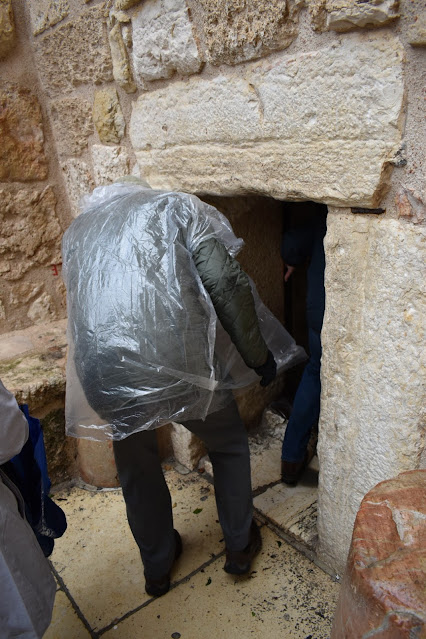 |
| Humility or Protective Measure? |
Upon stepping into the church, we see high ceilings with lights dangling down from the ceiling.
The columns have artwork on them, depicting many people.
Two nearly identical photos have a slight difference. One focuses a little more on the background.
The other focuses more upon the reflective ball. Now I'm represented in the photo.
When one looks up toward the windows, one discovers various works of art up there.
We didn't have to wait the hours one might have to wait during the busy season because we came during their off-season. That can make a huge difference of multiple hours of standing without an option of sitting.
As we neared the front of the space, we were told about a man who would be selling candles just beyond the transition of rooms. The room ahead looks very interesting. I bought a couple of candles, and gave one to a friend who had a birthday shortly after my return. It seemed fitting to give a gift from the place where Jesus was born to someone for their birthday.
The next room really did have lots of stuff all over the place. Various artifacts, pieces of art, etc.
I wish these weren't so darkened. Hopefully they can restore some of these works of art sometime.
This next photo is a quick look back to the main body of the church.
We eventually reached the area where everyone spreads out in an arc in order to go down the steps to the birthplace so we can arrive more as a group. As our priest pointed out beforehand, this is the worst part of the design. Everyone will want to get down, but rather than having the stairs work like most staircases that allow people to go down one or two at a time in a fairly straight line, these steps fan out in arcs. Thus, we start with room for perhaps a couple dozen people to stand on the top of the steps, and by the time we get to the bottom, that's when we were going to get down to just one person wide. So lots of people of all ages are stuck standing on steps without any handrails, and having to take turns letting someone ahead of you or deciding to step down a step. This narrowing on a downward staircase is a terrible design. Hopefully people are charitable.
While waiting to go down or while starting to go down the steps, one can look around at much more art.
This is a more natural photo compared to the first photo displayed in this post. The first photo was taken close to the same time, but under different lighting conditions. You can already see a hint of bright light on some faces, but it's not the intense glow of the other photo.
Just above the entryway to the final staircase.
The single-file part of the stairs is more reasonable.
After going down the rest of the way, one looks to the right and sees the silver star with the hole in it, which allows you to place your hand on the spot that's traditionally considered the birthplace of Jesus. This spot does bring humility.
Above the birthplace, it looks like this.
Stepping back quite a bit into an area that looks like it might be under restoration, I saw this.
But before taking that last photo, I took this photo, which is to the right in the last photo. This is where the crib of Jesus would have been. If one is standing right in front of the birthplace, this is back and to your right by just a few feet.
When leaving, we exit to the left of the birthplace of Jesus, heading up similar steps as we used to get down. But these make more sense, because people will start single-file, and can always choose to spread out. This works much better than using this same design to consolidate people to a single point.
This was a great site to visit. I wanted to end with the birthplace of Jesus for this church. So I split the next part into a separate post. We would exit this church to the north, and there, we enter another church with some history.





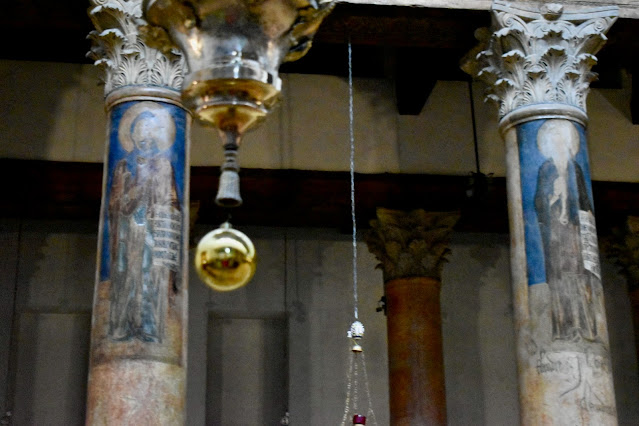









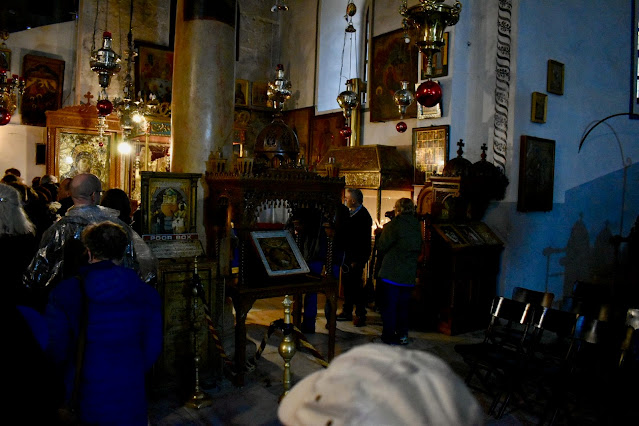





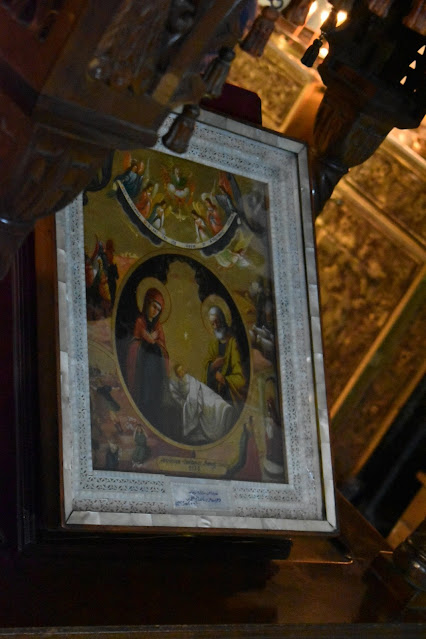










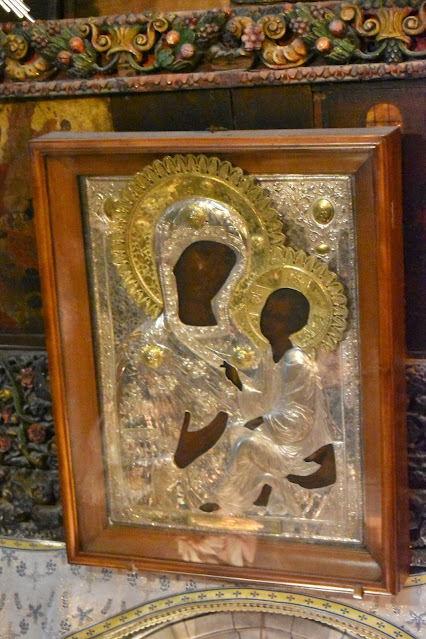





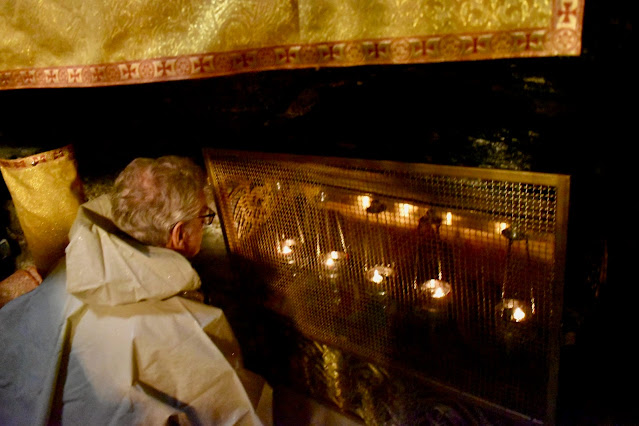

Comments
Post a Comment